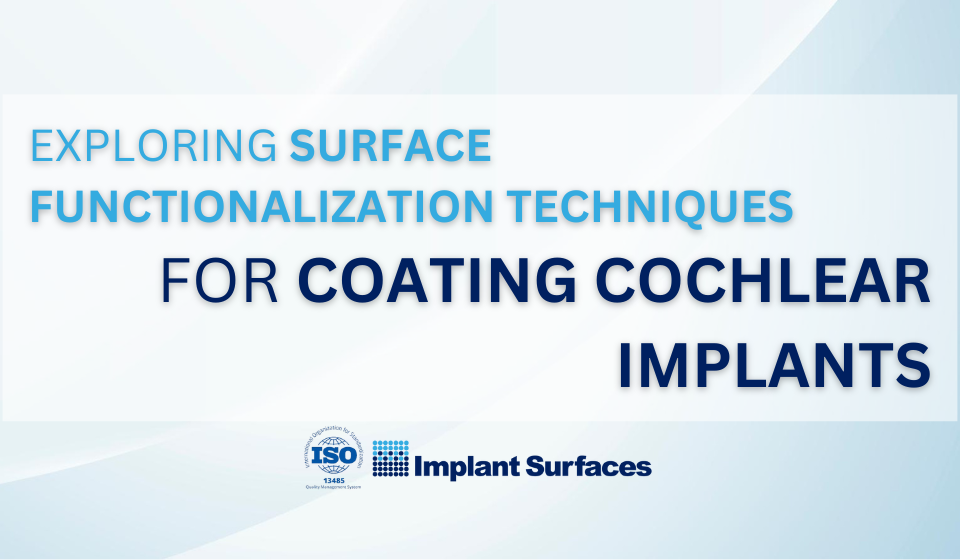
Biomechanical Considerations in Designing Coatings for Cranial Implants
April 26, 2024
Unveiling the Influence of Surface Roughness on Soft Tissue Adhesion in Dental Implants
April 28, 2024In the realm of orthopedic implantology, the pursuit of enhancing patient outcomes and reducing post-operative complications has been a driving force behind technological innovations. Among these, silver nanoparticle coatings have emerged as a promising solution for combating bacterial infections and improving the longevity of orthopedic implants. This article delves into the science behind silver nanoparticle coatings, their mechanism of action, and their potential applications in orthopedic surgery.
Orthopedic implants, such as joint replacements and fracture fixation devices, play a crucial role in restoring mobility and functionality to patients with musculoskeletal injuries or degenerative conditions. However, one of the significant challenges associated with these implants is the risk of bacterial infections, which can lead to implant failure, prolonged hospitalization, and increased healthcare costs. In recent years, there has been growing interest in developing antimicrobial coatings to mitigate this risk and improve the clinical outcomes of orthopedic procedures.
Silver has long been recognized for its potent antimicrobial properties, dating back to ancient civilizations where it was used for wound healing and water purification. Silver nanoparticles, due to their high surface area-to-volume ratio and unique physicochemical properties, exhibit enhanced antibacterial efficacy compared to bulk silver. When incorporated into implant coatings, silver nanoparticles can effectively inhibit the growth of a broad spectrum of bacteria, including both Gram-positive and Gram-negative strains.
The antimicrobial action of silver nanoparticles is multifaceted, involving several mechanisms. Firstly, silver nanoparticles disrupt bacterial cell membranes, leading to increased membrane permeability and leakage of cellular contents. Additionally, silver ions released from the nanoparticles interfere with vital cellular processes, such as DNA replication and protein synthesis, ultimately leading to bacterial cell death. Moreover, silver nanoparticles exhibit synergistic effects when combined with conventional antibiotics, allowing for lower antibiotic concentrations and reducing the risk of antibiotic resistance.
In the context of orthopedic implants, silver nanoparticle coatings offer several advantages for infection prevention and implant longevity. Firstly, these coatings provide a physical barrier against bacterial colonization on the implant surface, reducing the risk of biofilm formation and subsequent infection. Additionally, the sustained release of silver ions from the nanoparticles ensures long-term antimicrobial protection, even in the presence of physiological fluids. This prolonged efficacy is particularly beneficial in orthopedic applications, where implants are exposed to challenging microbial environments within the body.
Furthermore, silver nanoparticle coatings can be tailored to specific implant materials and geometries, ensuring compatibility and seamless integration with existing implant designs. Advances in coating technologies have facilitated the deposition of uniform and durable silver nanoparticle layers on various implant surfaces, including titanium, stainless steel, and biocompatible polymers. These coatings can be applied using techniques such as physical vapor deposition, electrochemical deposition, and plasma spraying, allowing for precise control over coating thickness and distribution.
In conclusion, silver nanoparticle coatings represent a promising strategy for enhancing the antibacterial properties of orthopedic implants and reducing the incidence of implant-related infections. By leveraging the unique antimicrobial properties of silver, these coatings offer a versatile and effective solution for improving the safety and longevity of orthopedic procedures. As research continues to elucidate the mechanisms of action and optimize the performance of silver nanoparticle coatings, their widespread adoption in clinical practice holds the potential to revolutionize the field of orthopedic surgery, ensuring better outcomes for patients and enhancing overall implant performance.




